Boost Your Demolition Bids – Request a Precision Estimate!
- Accurancy
- Efficiency
- Transparency
- Customization
- Time Saving
- Professionalism
- Cost Control
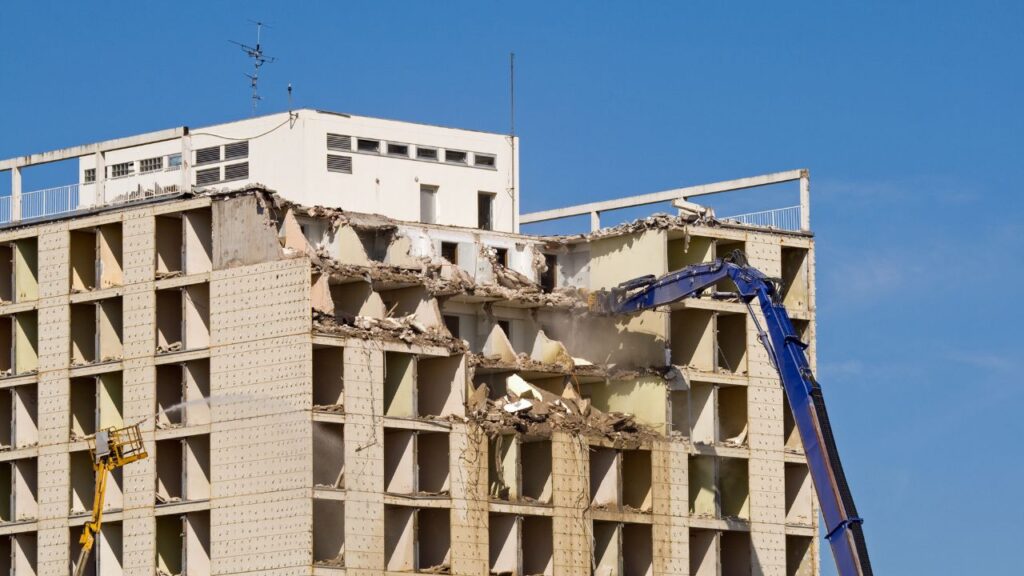
School building demolition is a significant undertaking that requires careful planning, adherence to safety regulations, and a thorough understanding of the various factors influencing costs. Whether it’s to make way for a new educational facility or repurpose the land, estimating demolition costs accurately is crucial. In this article, we will delve into the key considerations that impact the cost of school building demolition and provide insights into the planning process.
The size and complexity of a school building form the cornerstone of considerations in estimating demolition costs. Larger structures with sprawling layouts, intricate designs, or multiple interconnected buildings inherently demand more resources for demolition. The sheer scale of these projects requires increased labor, specialized equipment, and an extended timeframe, all contributing to higher costs. Moreover, when dealing with school buildings that house specialized features like gymnasiums, auditoriums, and classrooms with unique configurations, the complexity of the demolition process intensifies.
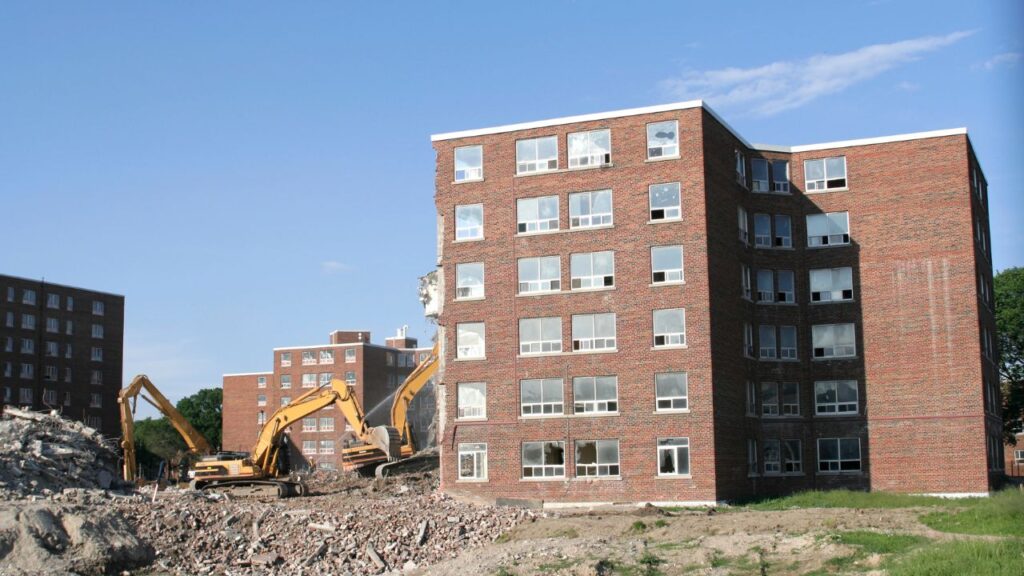
This complexity necessitates careful planning and execution, emphasizing the importance of a thorough evaluation of the school’s size and intricacies in estimating accurate demolition costs.
The materials used in the construction of a school building wield significant influence over demolition costs. Structures composed of durable materials such as reinforced concrete or steel require specialized equipment and techniques for efficient and safe dismantling. The robust nature of these materials often means that the demolition process demands additional effort and resources, subsequently impacting the overall budget. Understanding the specific materials that make up the school building is imperative for an accurate cost estimation. This knowledge allows demolition professionals to plan for the unique challenges associated with different construction materials, ensuring a safe and effective demolition process.

Fully Insured Licensed Hire Contractor For Demolition
Hire Contractor
Make Informed Design Decisions Showcase Your Design Ideas
Get RenderingSchool buildings, particularly those constructed in earlier decades, may harbor hazardous materials like asbestos. Identifying and properly handling these materials during the demolition process is not only crucial for the safety of the workers but also for compliance with stringent environmental regulations. The presence of hazardous materials adds a layer of complexity to the demolition project, often requiring specialized procedures for removal and disposal. Consequently, costs associated with environmental assessments, safe handling, and proper disposal of hazardous materials must be factored into the overall demolition budget.
The accessibility of the demolition site significantly influences logistical aspects and, consequently, costs. If a school is situated in challenging terrains or densely populated areas, additional planning and resources are necessary for transportation of heavy machinery and debris removal. Remote locations may require more extensive coordination and increased costs for transporting equipment, impacting the overall budget. Addressing potential challenges related to site accessibility during the planning phase is essential to develop efficient strategies that minimize transportation costs and streamline the demolition process.
Before the actual demolition can commence, the disconnection and removal of utility connections, such as water, electricity, and gas, are essential steps. Furthermore, attention must be given to the removal of underground infrastructure, such as sewage systems or foundations. These tasks often demand specialized attention and equipment, contributing to the overall budget. Properly accounting for the comprehensive removal of utilities and infrastructure ensures a smoother and safer demolition process, mitigating potential complications during the project.
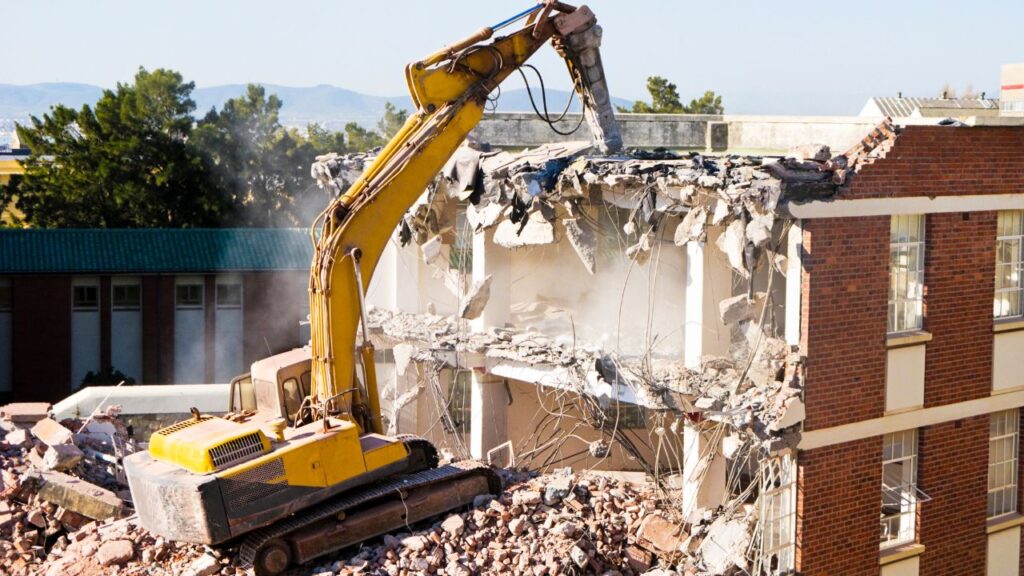
Securing the necessary permits and adhering to local regulations constitute integral components of the school building demolition process. The administrative efforts involved in obtaining permits contribute to the overall budget, and any delays in the permit approval process can impact the timeline and escalate associated costs. Rigorous adherence to regulatory requirements is crucial not only for legal compliance but also for maintaining a structured and efficient demolition timeline, underscoring the importance of meticulous planning in this aspect of the project. The cost associated with permitting and regulatory compliance reflects the commitment to conducting the demolition responsibly and in accordance with established guidelines.
Demolition, as part of redevelopment and urban renewal initiatives, plays a pivotal role in transforming outdated or underutilized spaces into modern, vibrant urban areas. The decision to demolish existing structures is often driven by the need to accommodate changing demographics, economic demands, and evolving urban planning goals. By clearing the way for new construction projects, cities can optimize land use, introduce contemporary architecture, and enhance overall aesthetics. Urban renewal through demolition contributes not only to the physical transformation of the landscape but also to the creation of dynamic, mixed-use spaces that attract businesses, residents, and visitors. This deliberate effort to rejuvenate urban environments is essential for fostering sustainable growth, economic development, and a higher quality of life for the community.

Demolishing buildings due to safety concerns is a paramount decision made to protect public safety and prevent potential hazards. Structures that are structurally compromised, unsafe, or damaged beyond repair pose a significant risk to occupants and the surrounding community. Whether a building has suffered from natural disasters, deterioration over time, or other structural issues, demolition becomes the necessary solution to eliminate the threat of accidents or collapses. Prioritizing safety through timely and responsible demolition ensures that the built environment aligns with rigorous safety standards, safeguarding lives and property from the potential dangers associated with unstable structures.
The repurposing of land often necessitates the demolition of existing structures to align with new development goals and land-use plans. This can include the conversion of industrial areas into residential or commercial spaces, responding to changing demands and trends in urban planning. Demolition in the context of land repurposing enables a strategic transformation of the built environment, allowing communities to adapt to evolving needs. It fosters sustainability by optimizing land utilization, facilitating mixed-use developments, and enhancing the overall functionality of the urban landscape. Land repurposing through demolition reflects a proactive approach to urban development, ensuring that available spaces are utilized in ways that best serve the community’s current and future needs.
Demolition becomes a necessary step in environmental remediation when buildings or sites are contaminated with hazardous materials. In cases where structures harbor pollutants such as asbestos or other toxic substances, demolishing the affected buildings is a key component of addressing environmental risks. The removal of contaminated structures allows for thorough cleanup efforts, preventing further environmental damage and safeguarding the health of nearby ecosystems and communities.
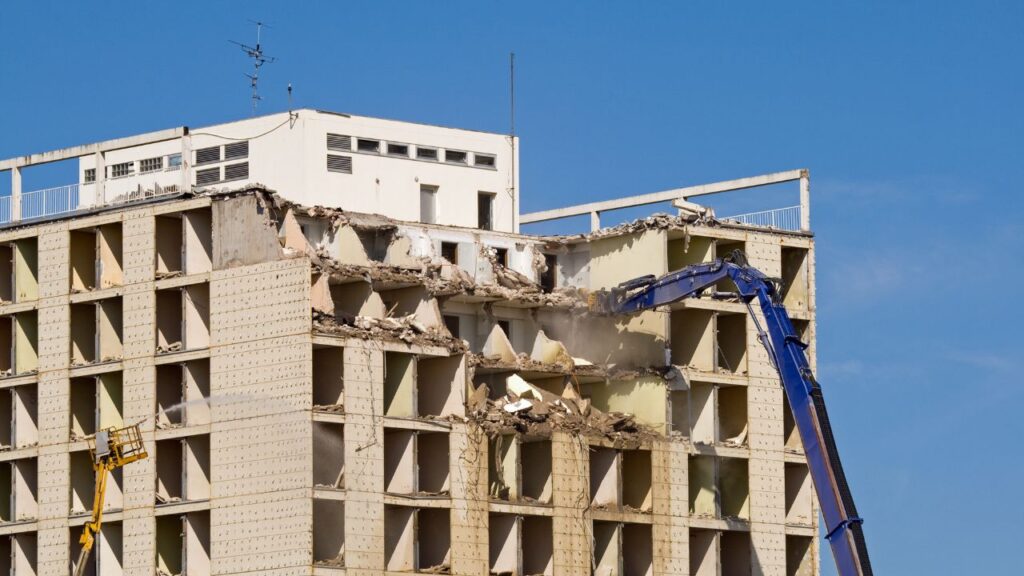
This environmentally conscious approach to demolition underscores the importance of balancing development with ecological responsibility, ensuring that contaminated sites are rehabilitated for future use without compromising environmental integrity.
The progress of large-scale infrastructure projects often requires the removal of existing structures, making demolition an integral step in the development process. Infrastructure projects, ranging from the construction of highways and bridges to the establishment of public facilities, may demand the clearance of space occupied by obsolete or incompatible structures. Demolition in the context of infrastructure development ensures that the landscape is optimized for the efficient implementation of projects that contribute to the region’s connectivity, accessibility, and overall development. It reflects a forward-thinking approach to urban planning, where the removal of existing structures becomes a strategic necessity to pave the way for essential infrastructure improvements that benefit the community at large.
Conducting a thorough site assessment stands as a foundational and indispensable step in any demolition project. This comprehensive evaluation involves a meticulous examination of the property to identify potential challenges, assess the condition of existing structures, and uncover any hazardous materials that may pose risks during the demolition process. This knowledge forms the bedrock upon which the entire demolition plan is built. Understanding the intricacies of the site, including terrain irregularities, structural weaknesses, and the presence of environmental risks, is crucial. Moreover, identifying and addressing hazardous materials, such as asbestos, during the site assessment ensures that the demolition plan incorporates specific procedures for their safe removal and disposal. The insights gained from this assessment contribute not only to the safety of the demolition team but also to the overall environmental responsibility of the project, fostering a well-informed and proactive approach to the challenges that may arise during the demolition process.
Collaborating with seasoned professionals is paramount for the success of any demolition project. This collaborative approach involves consulting with experienced demolition contractors, engineers, and environmental specialists, each bringing their unique expertise to the table. Demolition contractors offer practical knowledge of efficient demolition techniques, engineers contribute structural expertise to ensure the safe dismantling of buildings, and environmental specialists assist in navigating the regulatory landscape, ensuring compliance with environmental regulations. The synergy of these professionals enhances the overall efficiency, safety, and success of the demolition plan. Engaging professionals goes beyond a mere consultation; it is a strategic investment in the project’s success, ensuring that potential challenges are proactively addressed and that the demolition aligns with industry best practices and regulatory requirements.
Incorporating a contingency fund into the budget is a prudent and strategic financial measure in the realm of demolition projects. Contingencies, typically ranging from 10% to 20% of the total estimated cost, serve as a financial buffer to absorb unforeseen circumstances that may arise during the demolition process. Unanticipated challenges, such as the discovery of additional hazardous materials or changes in project scope, are not uncommon in demolition projects. The contingency fund allows for adaptability in the face of evolving project requirements, ensuring that the financial aspect of the project remains resilient. This proactive approach to budgeting mitigates the impact of unexpected events, providing the necessary financial flexibility to navigate challenges and maintain the project’s overall fiscal health.
Developing a realistic project timeline is a critical aspect of efficient planning in the demolition process. This involves a comprehensive consideration of various factors, including weather conditions, permitting procedures, and the overall complexity of the project. A meticulously planned timeline serves as a roadmap, helping to mitigate potential delays and the associated costs that may arise during the demolition process. Weather-related considerations, such as rain or extreme temperatures, can impact outdoor demolition activities, while the permitting process involves coordination with regulatory authorities.
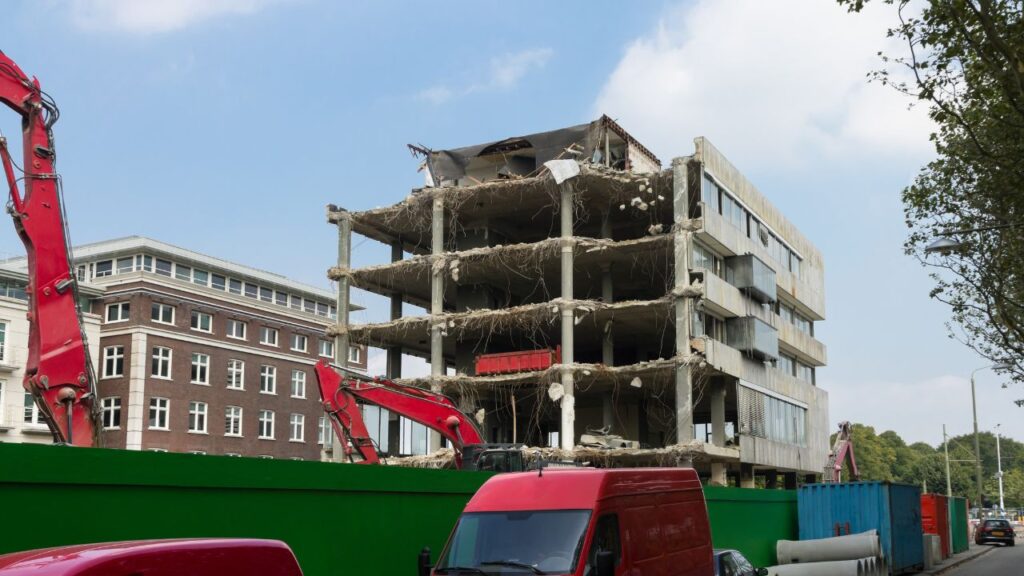
An accurate timeline not only ensures that project milestones are met but also facilitates effective communication with stakeholders. By factoring in the complexities and variables inherent in the demolition process, a well-planned timeline becomes an invaluable tool for project managers, allowing them to proactively address challenges and maintain a streamlined and efficient demolition process.
Implementing selective demolition involves a strategic and meticulous approach to dismantling structures, focusing on the preservation and salvage of valuable materials. This method stands in stark contrast to complete and indiscriminate demolition, aiming to minimize waste and reduce disposal costs. By carefully disassembling specific components, such as salvaging reusable metals, concrete, and wood, this approach not only contributes to cost savings but also aligns with sustainable practices. The emphasis on selective demolition underscores a commitment to environmental responsibility and resource efficiency, making it a cornerstone strategy for demolition projects seeking both financial and ecological benefits.
A fundamental pillar of environmentally conscious demolition is the prioritization of recycling and reusing materials. By actively seeking opportunities to recycle metals, concrete, wood, and other salvageable materials from demolished structures, the project not only reduces the burden on landfills but also contributes to broader environmental sustainability goals. Recycling materials not only lowers disposal costs but also promotes resource efficiency, ensuring that valuable materials find new life in subsequent construction projects. This commitment to circular economy principles establishes a responsible and forward-thinking approach to demolition, aligning the project with environmental stewardship.
Thorough site assessment stands as a cornerstone of effective demolition planning. This comprehensive evaluation involves a meticulous examination of the property to identify potential challenges, assess the condition of existing structures, and uncover any hazardous materials. The knowledge gained from this assessment informs the demolition plan, ensuring a well-informed approach that considers the intricacies of the site. By identifying and addressing potential challenges early in the planning phase, project managers can minimize unexpected expenses, streamline operations, and contribute to the overall success of the demolition project.

Fully Insured Licensed Hire Contractor For Demolition
Hire Contractor
Make Informed Design Decisions Showcase Your Design Ideas
Get RenderingEmbracing advanced demolition technologies and methodologies is pivotal for enhancing project efficiency, reducing labor costs, and accelerating timelines. Innovations such as robotic demolition equipment, building information modeling (BIM), and advanced demolition techniques enable a more precise and streamlined demolition process. Technology adoption not only improves the speed and accuracy of the demolition but also enhances worker safety and minimizes the environmental impact of the project. By staying at the forefront of technological advancements, demolition projects can achieve a higher level of precision, efficiency, and overall project success.
Encouraging competitive bidding among demolition contractors is a strategic approach to obtain favorable pricing while considering the experience and reputation of potential partners. This competitive environment compels contractors to offer cost-effective solutions without compromising on quality. Through a thorough evaluation of bids, project owners can select a contractor that not only aligns with budgetary constraints but also possesses the expertise to successfully execute the demolition project. Competitive bidding promotes transparency, efficiency, and ensures that the selected contractor is best suited to meet the project’s specific requirements.
Strategic deconstruction methods prioritize the careful disassembly of structures, aiming to salvage materials for reuse or recycling. This approach requires a more intricate and deliberate process compared to traditional demolition but offers significant advantages. By salvaging materials such as bricks, metals, or wood, strategic deconstruction not only reduces disposal costs but also contributes to sustainable construction practices. The emphasis on preserving valuable components aligns with a broader commitment to resource efficiency and environmental responsibility, making strategic deconstruction a compelling strategy for demolition projects with a focus on long-term sustainability.
Implementing thorough risk management practices is imperative in the demolition process to identify and mitigate potential challenges that could lead to cost overruns. A proactive approach to risk assessment involves anticipating and addressing uncertainties, such as unforeseen structural complexities or environmental issues. By developing contingency plans and having a robust risk management strategy in place, project managers can minimize the financial impact of unexpected events, ensuring that the demolition project remains on schedule and within budget. Risk management is a foundational element in successful demolition planning, providing a safeguard against potential setbacks and enhancing overall project resilience.
The demolition of school buildings is a intricate process influenced by factors such as size, construction materials, and regulatory compliance. The need for demolition arises from urban development, safety concerns, land repurposing, environmental remediation, and infrastructure projects. Successful planning involves a thorough site assessment, professional collaboration, budget contingencies, and a realistic timeline. Cost-saving strategies like selective demolition, recycling, careful planning, technology adoption, competitive bidding, strategic deconstruction, and risk management contribute to financial efficiency and environmental sustainability. A balanced approach to these considerations ensures the success of school building demolition projects, fostering safer, more sustainable urban environments.
School building demolition becomes necessary for various reasons, including urban redevelopment, safety concerns due to structural issues, repurposing land for different uses, environmental remediation of hazardous materials, and to make way for large-scale infrastructure projects.
The cost of demolition is influenced by factors such as the size and complexity of the building, construction materials, presence of hazardous materials, site accessibility, utilities and infrastructure removal, and compliance with permitting and regulatory requirements.
Hazardous materials, such as asbestos, can significantly impact demolition costs. Identifying and safely removing these materials in compliance with environmental regulations adds complexity to the process and requires specialized procedures, affecting the overall budget.
Site accessibility plays a crucial role in logistical aspects and cost considerations. If the school is located in challenging terrains or densely populated areas, additional planning and resources are required for the transportation of heavy machinery and debris removal, influencing the overall budget.
Disconnection and removal of utility connections, such as water, electricity, and gas, are essential steps in the demolition process. Removal of underground infrastructure, like sewage systems or foundations, requires specialized attention and equipment, contributing to the overall budget.
Obtaining necessary permits and complying with local regulations contribute to administrative costs. Delays in the permit approval process can impact the timeline and escalate associated costs, emphasizing the need for meticulous planning in this aspect of the project.
Cost-saving strategies include selective demolition to preserve valuable materials, recycling and reusing materials, careful planning and site assessment, technology adoption for enhanced efficiency, competitive bidding among contractors, strategic deconstruction methods, and thorough risk management.
Collaborating with experienced demolition contractors, engineers, and environmental specialists is crucial. Professionals bring practical knowledge, structural expertise, and regulatory compliance guidance, ensuring the overall efficiency, safety, and success of the demolition plan.
Here I am going to share some steps to get your school building demolition cost estimate report.
You can send us your plan on info@estimatorflorida.com
Before starting your project, we send you a quote for your service. That quote will have detailed information about your project. Here you will get information about the size, difficulty, complexity and bid date when determining pricing.
Our team will takeoff and estimate your project. When we deliver you’ll receive a PDF and an Excel file of your estimate. We can also offer construction lead generation services for the jobs you’d like to pursue further.



561-530-2845
info@estimatorflorida.com
Address
5245 Wiles Rd Apt 3-102 St. Pete Beach, FL 33073 United States
561-530-2845
info@estimatorflorida.com
Address
5245 Wiles Rd Apt 3-102 St. Pete Beach, FL 33073 United States
All copyright © Reserved | Designed By V Marketing Media | Disclaimer